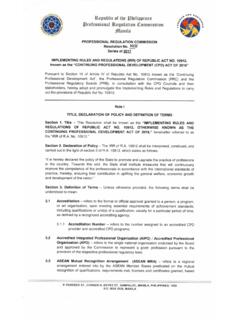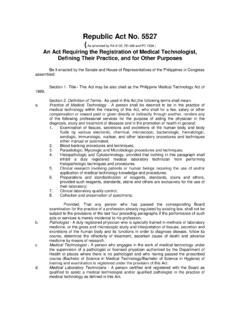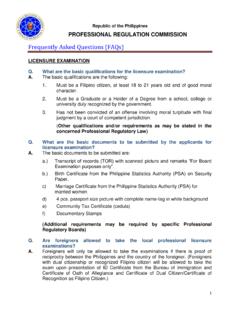Transcription of Promulgation of the Syllabi for the Subjects in the ...
1 Promulgation of the Syllabi for the Subjects in the Architecture Licensure Examination PREAMBLE 1. The following Syllabi are intended to guide prospective candidates in preparation for the Architecture Licensure Examination. In general, they cover areas in which examinees are expected to have knowledge, understanding, and competencies when they start to practice the architectural profession. 2. The general coverage of the examination is divided into three major areas with their corresponding weights as follows: a. History and theory of architecture; principles of planning; architectural practice (30%) b.
2 structural design; building materials and construction; utilities (30%) c. Architectural design and site planning (40%) 3. Each major area is subdivided into specific sub areas or concerns, as well as their corresponding rationale and description. 4. These Syllabi shall be made available to all recognized schools of architecture in the country, the United Architects of the Philippines, and other concerned entities. Area A HISTORY AND THEORY OF ARCHITECTURE; PRINCIPLES OF PLANNING; AND ARCHITECTURAL PRACTICE Part I HISTORY OF ARCHITECTURE A. Rationale and Description 1.
3 Analysis of architectural manifestations from the beginning of civilization to contemporary periods of development; 2. Analysis of the influences of environmental, historical, and sociocultural factors and their relevance to the development of art, buildings, structures, as well as of human settlements. B. Scope 1. Introduction a. History b. History of architecture c. Historic style of architecture d. Origin of architecture e. Factors affecting the style of architecture 2. Pre-Historic Architecture a. Centers of development b. Dolmen, Menhir, Cromlech 3.
4 Historic Styles of Architecture a. Period/extent and centers of development b. Factors that affect the development of architectural style (historical, environmental, and socio-cultural) c. General characteristics (architectural, structural , decorative) d. General contributions e. Notable examples Ancient architecture and the Western succession a. Egyptian b. West Asiatic c. Greek d. Roman e. Early Christian f. Byzantine g. Romanesque Architecture in Europe h. Gothic Architecture in Europe i. Renaissance Architecture in Europe j. Nineteenth and Twentieth Century in Great Britain k.
5 Architecture of Africa, Australia, and New Zealand l. Nineteenth and Twentieth Century architecture in Continental Europe m. Architecture of the Americas Architecture in Asia and the Pacific Region Architecture in the Philippines a. Architectural legacies b. Architectural preservation, conservation, and restoration c. Pillars of Philippine Architecture Part II THEORY OF ARCHITECTURE A. Rationale and Description 1. Understanding of the theories and principles of design and architectural design process; 2. Analysis of anthropometric, proxemic, and kinesthetic requirements of space in relation to architectural design; 3.
6 Analysis of sociocultural and technological trends which are contributory to the development of contemporary architecture B. Scope 1. Introduction a. The nature of architecture b. Architecture as art and science c. Processes in architectural design 2. Elements of Architecture and Basic Principles of Design a. Need-specific elements b. structural , circulatory protective, and decorative elements c. Influences in architectural design d. Basic principles of design 3. Design Perception a. Anthropometric basis of architectural design b. Space articulation and territoriality c.
7 Visual and perceptual language d. Psychology of space e. Proxemics and culture 4. Tropical Architecture a. Influences and elements of tropical architecture b. Specific examples of tropical architecture 5. Masters of Architecture a. Philosophies of Great Architects b. Examples of great works Part III ARCHITECTURAL PRACTICE A. Rationale and Description 1. Understanding of the role, legal rights and obligations, and responsibilities of the architect; 2. Analysis and application of the various statutes, codes, and regulations affecting the practice of architecture in the Philippines; 3.
8 Understanding of the various aspects of the professional practice of architecture, including tools and techniques related to production, construction, resource allocation, and project management, as well as the efficient conduct of client and business relations for building design and construction projects. B. Scope 1. Certification of Architects and Standards of Professional Practice a. Statutes regulating the practice of architecture in the Philippines b. Professional organization of architects c. Architects- Code of Ethics d. Rights and responsibilities of the profession e.
9 Spectrum of architectural services f. Architectural fees and charges g. Architectural competitions 2. Building Standards, Laws, and Regulations a. Architectural design standards, building and construction-related laws b. Laws on real estate and subdivisions c. Laws on housing and human settlements 3. Aspects of Architectural Practice a. Operating divisions of architectural practice, development, production, administration, and management (with emphasis on preparation of contract documents) b. Specifications writing and quantity surveying c. Legal and business aspects of architectural practice Part IV THEORY AND PRINCIPLES OF PLANNING A.
10 Rationale and Description 1. Analysis of the concepts and techniques in the general planning process, urban and regional planning, land use planning, and human settlements planning; 2. Understanding of the art and science of site planning with emphasis on ecological, socio-psychological, aesthetic, and functional basis of site planning. B. Scope 1. General Principles of Planning a. Definitions and classification b. History and scope of planning c. General planning process 2. Urban and Regional Planning and Urban Design a. History of the city and the region b.













